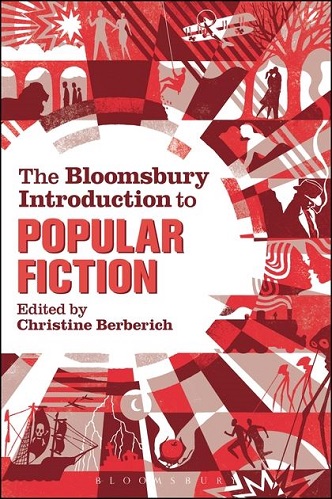
by by Margaret Kolb

Published by Bloomsbury Academic, 2015 | 344 pages pages
On September 4th, 1935, A.A. Wyn, a prominent publisher of pulpwood magazines such as Detective Drag-net, Western Trails, and Love Fiction Monthly, wrote the editor of The New York Times to defend the literary merit of his popular publishing enterprises: "You may laugh at the stories we use, you may laugh at the paper we use [...] But you can't quite laugh at the 10,000,000 Americans who plunk down their hard-earned cash each month for their favorite magazine." It's a revealing passage, coming as it did in the years immediately following the peak of high modernism. The legacy of titans such as James Joyce, William Faulkner, Virginia Woolf, Franz Kafka, Marcel Proust, Wallace Stevens was untouchable then, and so we find Wyn justifying the value of his product based not on aesthetic merit but rather on its populist appeal. This came only a decade after The Little Review had given Modernism a rallying cry with its promise, blazed on the front cover of each issue: "Making No Compromise with the Public Taste." The most provocative part of Wyn’s defense, however, was still to come. He continues, "Who knows what some future historian may say about the relative merits of the forests of pulp that go into the magazines and books of today? After all, the masses throughout the world enjoyed the entertainment of slapstick Charlie Chaplin long before the highbrows discovered that he was an artist 'incomparable.'" Little could Wyn have known how prophetic these lines would prove to be.
Surprising as it may be, "popular literature" as we understand it first appeared only a century or so ago. Before the Industrial Revolution, the immense labors required to print and distribute books conspired to imbue printed works, despite quality of writing, with a halo of cultural and literary legitimacy. If someone bothered to publish it, it was implied, it was probably pretty "important," something to take "seriously" and model after previous “important” authors. The times were not yet ripe for the emergence of a mature literary community that did not explicitly align itself with – nor lament its choice not to do so – the likes of a Dante, a Milton or an Austen. Circumstances changed, however, with the spread of the industrial revolution and its printing presses, industrial scale production of cheap paper and ink, and establishment of a broad popular book and newspaper market and democratizing lending network. Such advances made possible, and gave encouragement to, the revolution in our conception of literature that was to unfold in the years before and after the dawn of the 20th century.
This revolution was accompanied by a pronounced increase in what literary scholar Sean Latham frames as rhetorical displays of cultural refinement, otherwise denigrated as "snobbery," a pose he argues "matche[s] with uncanny precision the rise of both aesthetic modernism and modern mass-mediated culture." Spurred on by the productive power of industrialized printing, and the exponentially proliferating supply and diversity of materials – generated by an ever-growing army of wage writers of varying skill – cultural elites such as Stéphane Mallarmé (1842-1898), Charles Baudelaire (1821-1867), Ezra Pound (1885-1972), and Virginia Woolf (1882-1941) drew a sharp distinction between their artistic practice and the alleged ephemeral writings of the new popular literature, insisting that a vast chasm of value – "the great divide," as literary scholar Andreas Huyssen has termed it – separated the two. As anyone who has read the French Symbolists or the high modernists will attest, this cadre of 19th and early 20th-century authors went to immense ends to distinguish themselves from popular writers, journalists, and the new class of literary professionals who published for the increasingly literate masses.
Interestingly, it is at precisely this moment that an unapologetic and assertive popular literature first crystallizes in the writings of the pioneers of genre fiction. True, we find throughout the industrial revolution a number of significant proto-popular authors influencing the French symbolists and Modernists: Mary Shelley (1797-1851), Edgar Allen Poe (1809-1849), and H.G. Wells (1866-1946), etc. But it is with the generation of popular writers that wrote in the first decades of the twentieth century – for example H.P. Lovecraft (1890-1937), Clark Ashton Smith (1893-1961), and Robert E. Howard (1906-1936) – that we find authors who, far from apologizing for the marginalized and ephemeral nature of the cheap periodicals they published in, instead came to align their artistic aspirations within their respective genre’s print cultures. "Destruction hastens and intensifies / the process that is beauty," Clark Ashton Smith wrote in "Nero" (1912), celebrating, perhaps, the acid-rich paper his work would be printed on in the pulpwoods. In this way something like a negative history to 20th-century literary modernism emerges here, most defiantly in the pulp aesthetic of the interwar period and the popular genres of science fiction, fantasy, and supernatural horror.
The Bloomsbury Introduction to Popular Literature, a collection of essays edited by Christine Berberich, touches upon a wide variety of aspects of the history of these popular genres. Common to many of these essays is the historical and theoretical ambiguity of the "popular" nature of these genres. "It is tempting to say," writes Berberich in her introduction, "that popular fiction indicates writing that is [...] enjoyed by many readers. However, it is not that simple." She continues: "the term popular contains a variety of different and, potentially, contradictory meanings, and is one weighed down with ideological meaning." As a case in point, consider the interwar sword and sorcery stories of pulpwood writer Robert E. Howard (1906-1936). Following their publication, Howard’s "Conan the Cimmerian" stories would achieve mass influence as the inspiration for popular comic books, multiple Hollywood productions, video games, and television shows. This "Conan as [popular] cultural production," as literary scholar Jonas Prida terms it, has largely eclipsed Howard's literary character. And yet Howard’s fiction remains significant, not merely due to its lasting influence, but also for its formal innovations, artistic ambition, technical prowess, not to mention the window it provides into the fantasies and anxieties of its audience and era of publication.
Berberich's anthology powerfully illuminates the curatorial, arguably censorial role, of high culture, in particular that of interwar literary magazines like The Atlantic and Harper’s. Not only do aesthetically ambitious literary magazines vehiculate literature to readers, they also curate the literary archive, selecting and highlighting the "worthy." No contributor here wholly disputes the facts of publishing and artistic consumption: attention and space are limited, and accordingly literary canons and critical traditions that highlight distinguished artistic and literary accomplishments are not without their value. What The Bloomsbury Introduction to Popular Fiction does, however, is remind readers that literary traditions are constructions, and that the formation of canons are skewed by what literary scholar David M. Earle calls the "prejudice of form." If a work was serialized in a newspaper, for example, published in a pulpwood magazine, or strewn with brightly colored illustrations depicting cowboys in space with lasers, it may be judged and rejected without the actual quality of the writing itself ever being taken into consideration.
If The Bloomsbury Introduction to Popular Literature succeeds in productively estranging the literary archive, it also, perhaps inadvertently, exposes its own reliance upon (alternative) canons by focusing on well-known authors of popular genres, such as H.G. Wells (1866-1946; sciencefiction), Ian Fleming (1908-1964; international espionage), and H.P. Lovecraft (horror). Though the anthology frames the notion of "popular literature" and "canonicity" as fundamentally at odds, it nevertheless fails to acknowledge, or address, its own focus on these, and other, canonical names. It is a shame; the work would have benefited from a deeper excavation into the depths of each genre under consideration.
In an editorial titled, "Popular Fiction - As It is Today," published in 1930 in The Writer's Digest, a trade journal for pulpwood writers, the editor rejects out of hand the idea that popular fiction authors could ever write for "higher" ends: "Writing for pulp-paper magazines never can be anything but a trade. Writers should face it as such." Popular genres, the writer asserts – echoing literary prejudices residual from the high modernists and the pre-industrial age – are commercial enterprises, aesthetically inauthentic, and unworthy of sustained attention. What really stands out about this editorial, however, and the many published during the decades in which popular literature came of age, is not the case they attempt to make, but rather the underlying fact that their authors felt it necessary at all to reassert "high" literature’s superiority in the first place. It is clear in hindsight, surveying these tirades from the perspective of time, that popular fiction had transcended its relegated status and truly come of age.
Jason Ray Carney is a Lecturer at Christopher Newport University where he teaches popular literature and creative writing. His fiction has appeared in Beecher’s Magazine, The Blue Lake Review, and elsewhere. His scholarship has appeared in The Dark Man: The Journal of Robert E. Howard Studies, Lovecraftian Proceedings, and most recently in the The Unique Legacy of Weird Tales: The Evolution of Modern Fantasy and Horror.















click to see who
MAKE Magazine Publisher MAKE Literary Productions Managing Editor Chamandeep Bains Assistant Managing Editor and Web Editor Kenneth Guay Fiction Editor Kamilah Foreman Nonfiction Editor Jessica Anne Poetry Editor Joel Craig Intercambio Poetry Editor Daniel Borzutzky Intercambio Prose Editor Brenda Lozano Latin American Art Portfolio Editor Alejandro Almanza Pereda Reviews Editor Mark Molloy Portfolio Art Editor Sarah Kramer Creative Director Joshua Hauth, Hauthwares Webmaster Johnathan Crawford Proofreader/Copy Editor Sarah Kramer Associate Fiction Editors LC Fiore, Jim Kourlas, Kerstin Schaars Contributing Editors Kyle Beachy, Steffi Drewes, Katie Geha, Kathleen Rooney Social Media Coordinator Jennifer De Poorter
MAKE Literary Productions, NFP Co-directors, Sarah Dodson and Joel Craig